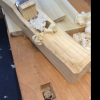Looks great! Is this your first traditional mortised plane? Either way, very nice job. The combination of plumb and pear is lovely; delicious, one might say! 
Two small comments. One, to echo George, hide glue would be a much better choice for the handle. Liquid hide glue is great for this purpose.
Also, the handle looks a bit too vertical to me, but that is perhaps a matter of choice.
Enjoy your new plane!
"For me, chairs and chairmaking are a means to an end. My real goal is to spend my days in a quiet, dustless shop doing hand work on an object that is beautiful, useful and fun to make." --Peter Galbert






 Reply With Quote
Reply With Quote



